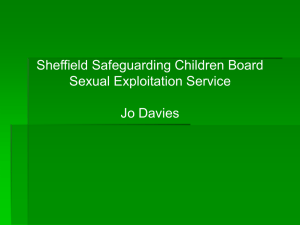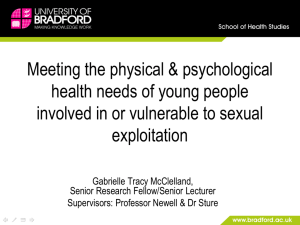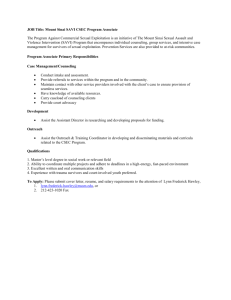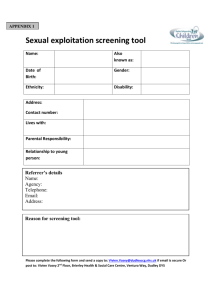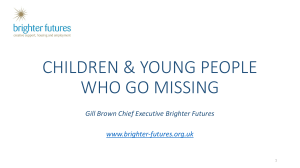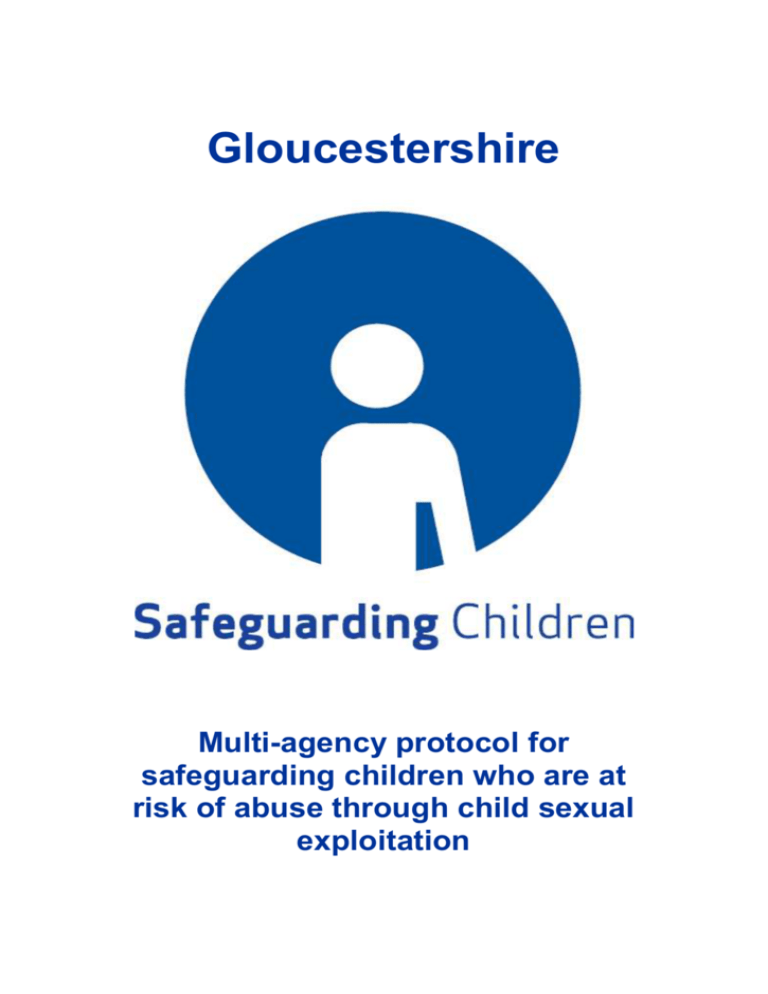
Gloucestershire
Multi-agency protocol for
safeguarding children who are at
risk of abuse through child sexual
exploitation
Contents
1. Introduction
1.1 Statement of Intent
1.2 Definition and scope
1.3 Protocol
2. Principles
2.1 A child-centred approach
2.2 A shared responsibility
2.3 Recognising criminality
2.4 Early proactive intervention
3. Vulnerability factors and response
3.1 Vulnerability factors to sexual exploitation
3.2 Risk assessment framework
3.3 Initial professional response
4. Intervention
4.1 Multi-agency risk management meetings
5. Responsibilities of agencies
5.1 All agencies
5.2 Children’s social care
5.3 Police
5.4 Education services
5.5 Health services
5.6 Voluntary groups & agencies
Appendix A: Risk assessment & intervention process
Appendix B: CSE screening tool
1. Introduction
1.1 Statement of intent
1.1.1 Sexual exploitation of children is child abuse and is unacceptable. Tackling
child sexual exploitation is one of the key priorities for the Gloucestershire
Safeguarding Children’s Board. Such exploitation can have serious long term impact
on every aspect of the child or young person’s life, as well as the lives of their
families.
1.1.2 It is our collective multi-agency responsibility to identify those children and
young people at risk of exploitation and our joint responsibilty to protect them and
safeguard them from further risk of harm. We shall also prevent children becoming
victims of this form of abuse and reassure our communities that we can perform our
duties effectively.
1.1.3 It is our clear intention to improve the lives of children living in
Gloucestershire. We will do so by ensuring children and young people understand
the risks of being exploited enabling them to cease contact with the perpetrators of
this abuse.
1.2 Definition and scope
1.2.1 The sexual exploitation of children and young people under 18 involves
exploitative situations, contexts and relationships where young people receive
‘something’ (e.g. food, accommodation, drugs, alcohol, cigarettes, affection, gifts,
money) as a result of engaging in sexual activities. This can occur through the use of
technology without the child’s immediate recognition, for example the persuasion to
post sexual images on the internet/mobile phones with no immediate payment or
gain. In all cases those exploiting the child/young person have power over them by
virtue of their age, gender, intellect, physical strength and/or economic or other
resources. Violence, coercion and intimidation are common, involvement in
exploitative relationships being characterised in the main by the child or young
person’s limited availability of choice resulting from their social/economic and/or
emotional vulnerability.1
1.2.2 In recognising child sexual exploitation as child abuse this protocol identifies
that children must be protected, and enabled to protect themselves, in all aspects of
their lives and relationships. The sexual exploitation of children and young people
crosses boundaries of culture, community groups, disability, social class, and gender.
1.3 Protocol
1.3.1 This protocol sets out a clear framework for supporting children who are
vulnerable to exploitation. It incorporates guidance on raising awareness of the issue,
on identifying risk, assessing and supporting children and their families, and
disrupting and prosecuting offenders.
1.3.2 This protocol is issued under the auspices of Working Together to Safeguard
Children (Children Act 1989 & Children Act 2004) and should be read in conjunction
1
Safeguarding Children and Young People from Sexual Exploitation; Supplementary
Guidance to Working Together to Safeguard Children. DCSF 2009
with the 2009 supplementary guidance from the Department for Children, Schools
and Families (DCSF) – “Safeguarding Children and Young People from Sexual
Exploitation” (http://www.education.gov.uk).
1.3.3 Children who go missing are particularly vulnerable to sexual exploitation. The
Gloucestershire Protocol for Children Who Run Away and Go Missing from Home
and Care outlines the county’s response to children who go missing.
1.3.4 Professionals should consult the Gloucestershire Child Protection Procedures
for concerns, decisions and actions related to, but not covered, in this procedure.
2. Principles
2.1 A child-centred approach:
2.1.1 All action to safeguard and promote the welfare of children and young people
who are, or at risk of, being sexually exploited should be child-centred and focussed
on their individual needs.
2.1.2 Parenting can be challenging and parents themselves sometimes require
support. Asking for help should be seen as a sign of responsibility rather than as a
failure. A child or young person suffering harm as a result of sexual exploitation by
someone outside the family is not necessarily indicative of the parents’ failure to
meet the needs of their child.
2.1.3 In such circumstances the needs of children and families should be assessed
and met within the context of the wider range of support and services which are
available to protect and support them.
2.2 A shared responsibility:
2.2.1 Safeguarding and promoting the welfare of children in the context of sexual
exploitation, like safeguarding more generally, depends on effective joint working
between agencies and practitioners that work with children and young people. The
involvement of different roles, experience and perspectives is essential if children
and young people are to be effectively supported and action taken against
perpetrators of sexual exploitation.
2.3 Recognising criminality:
2.3.1 Children who are sexually exploited are victims of child abuse and are suffering
harm. They are therefore not to be regarded as having bad or criminal behaviour;
they are victims of sexual abuse. The responsibility for the sexual exploitation of
children and young people lies with the abuser and proactive efforts must be made to
bring those offenders to justice.
2.3.2 Many sexually exploited children have difficulty distinguishing between their
own choices around sex and the sexual activities they are coerced into. This potential
confusion needs to be handled with care and sensitivity.
2.3.3 The primary law enforcement effort must be against the coercers and sex
abusers, who may be adults, but could also be the child’s peers or young people who
are older than the child.
2.4 Early proactive intervention:
2.4.1 Effectively safeguarding and promoting the welfare of children and young
people harmed through sexual exploitation requires professionals to consider
intervention at an early stage, i.e. as soon as young people become involved in
potentially risky activities.
2.4.2 Many young people engage in consensual sexual activity, treating each other
with respect and taking account of their health and future. Professionals must
develop the skills to enter into conversation with young people about their sexual
choices, in order to understand whether extra support is needed, or whether coercive
or exploitative behaviour is occurring.
2.4.3 Anyone who has regular contact with children and young people is in a good
position to notice subtle changes in behaviour or physical signs that indicate they
may be involved in a sexually exploitative situation.
2.4.4 Parents and carers, teachers, social workers, police officers, youth offending
services staff, school nurses, looked after children’s nurses, sexual health
practitioners and youth workers are particularly well placed to identify this risk.
2.4.5 Practitioners must be alert to the indicators of possible sexual exploitation and
agencies must be proactive in identifying the scale and scope of the sexual
exploitation of children in the county.
3. Vulnerability factors and responses
3.1 Vulnerability factors to sexual exploitation
3.1.1 Children are more vulnerable to abuse through sexual exploitation if they have
experience of one or more of the following:
Child sexual abuse;
Domestic violence within the family;
Family breakdown;
Physical abuse and emotional deprivation;
Bullying in or out of school;
Family involvement in sexual exploitation;
Parents with a high level of vulnerabilities (drug / alcohol, mental health etc);
Drug / alcohol, mental health or other difficulties themselves;
Involvement in gangs
Being looked after in residential care; and
Going missing frequently.
3.2 Risk assessment framework
3.2.1 A screening tool has been adopted to help professionals and workers from
both statutory and voluntary agencies consider the risk that a child is at from sexual
exploitation. Children and young people engage in sexual activity and not every
circumstance will be one of exploitation. It is therefore important that an informed
assessment is made of the individual situation of the child or young person.
3.2.2 Exploitation is characterised by the imbalance of power. A risk assessment
framework has been developed to help the police and social care establish whether a
child for whom there is concern is at risk of sexual exploitation and to assess the
level of that risk.
Category 1 (Not at risk): a child who may have some vulnerabilities present
but is not at risk of being targeted and groomed for sexual exploitation or who
has exited an exploitative situation and is no longer at risk.
Category 2 (Mild risk): vulnerable child where some concerns are present
about the longer term wellbeing of the child but their situation does not
currently present as an exploitative one.
Category 3 (Moderate risk): a child with a number of vulnerabilities and one or
more risk indicators present that put them at risk of exploitation, e.g. periods
of going missing, exclusion from school, lack of protective network, time spent
with inappropriate adults.
Category 4 (Significant risk): a vulnerable child with multiple risk indicators
present where there is a clear indication they are at significant risk of sexual
exploitation or are already being exploited.
3.2.3 The framework needs to be used flexibly to take account of the uniqueness of
each child’s circumstances and the changes that may occur for him / her over time.
3.2.4
The risk assessment framework is set out at Appendix B.
3.3 Initial professional response
3.3.1 Professionals in all agencies should be alert to the possibility that a child they
are in contact with may be being sexually exploited. The professional may already
have concerns about the child e.g. that s/he is missing school, frequently missing
from home, misusing substances, is depressed or self-harming etc.
3.3.2 Interventions to prevent sexual exploitation and support children to recover a
healthy lifestyle are more likely to be successful if a child who is at risk can be
identified and information about concerns shared within a multi-agency support
network as early as possible.
3.3.3 Professionals are often in a position of having to develop the child’s trust, or
having built it up are concerned about breaking that trust through the sharing of
confidential information with other agencies. These issues should be discussed with
the agency’s designated child protection officers, and efforts made to share
information as soon as possible.
3.3.4 Sharing information about the child with other agencies may reveal that the
child is at a different level of risk to that initially perceived. Therefore the professional
should discuss their concerns with their agency’s nominated safeguarding children
adviser and use the risk assessment framework to make a preliminary assessment of
the risk of harm to the child.
3.3.5 If the risk is identified as being mild, moderate or significant then a referral
should then be made into the Central Referral Unit with full details of the young
person and significant others provided.
3.3.6 The Central Referral Unit will share the information with Children’s Social
Care and an initial discussion will take place to agree next steps.
3.3.7 Where considered appropriate and useful a social worker will then make an
initial visit to the young person and their family to gather more information and
involve them in the process.
4. Intervention
4.1 Multi-agency risk management meetings
4.1.1 Children’s Social Care will respond in one of the following ways to the initial
visit to the child:
• An initial assessment may be undertaken to identify the child’s level of risk
and need for service provision;
• If the initial assessment identifies the child to be at risk of significant harm
this will necessitate a child protection enquiry and a core assessment of need
under section 47 of the Children Act 1989; or
• Where an initial assessment is not deemed necessary a plan of support may
be agreed between young person, parents and additional professionals or
non-statutory agencies where appropriate.
4.1.2 If the level of assessed risk is identified as being moderate or high then a risk
management meeting will be held. This will include police, social care, and other
relevant individuals. This does not replace strategy meetings where S.47 applies.
4.1.3 The child and their family should normally be made aware of the concerns,
engaged in developing the diversion plan and, if their safety would not be
compromised, involved in risk management meetings. However, engaging the child
and family and alerting them to the risks should be approached with a high level of
sensitivity to avoid compounding risks or furthering alienation. There may be
occasions when a child’s parent/carer may not be invited to attend the meeting.
4.1.4 Attendance at the risk management meeting should include representation
from the relevant agencies involved with the young person and other agencies that
are able to provide required support.
4.1.5
The purpose of the meeting should be to:
• Share and clarify information;
• Establish the exact nature of concerns;
• Establish risk for any other children, including siblings;
• Consider the likelihood of prosecution of relevant adults;
• Agree on action and make recommendations to address the concern;
• Develop a safety plan for the child and parent/carer;
• Work towards a recovery strategy; and
• Identify the factors to be taken into account (these will include the indicators
in the Risk Assessment Framework).
4.1.6 A record of the risk management meeting should be produced, together with
a safety plan. A lead professional will need to be allocated and they will hold
responsibility for co-ordinating the safety plan. Unless no further action is agreed, or
child protection procedures are invoked, a date for a review meeting should be
agreed. If the child’s parent/carer has not been present, the meeting must consider
what information to give at this point, and who should undertake this. Parents/carers
should usually be notified of concerns regarding their children, and what action is
being considered to address these.
4.1.7 As with all child sexual abuse, child sexual exploitation involves varying
degrees of coercion, reward, secrecy and fear, which means that interventions to
support children may need to be long-term, and safeguarding and support plans
should be progressed at the child’s pace.
5. Responsibilities of agencies
5.1 All agencies
5.1.1 Agencies from the following areas in particular have an integral role to play in
the protection of children and young people from sexual exploitation:
Children’s Services (Social Care and Education)
Policing
Health Providers
Youth Support Services
Crown Prosecution Service
Local voluntary sector providers
5.1.2 Each of the organisations engaged to co-operate in tackling child sexual
exploitation will be expected to agree to implement and adhere to the principles set
out within this protocol.
5.1.3 They will also be required to agree to an Information Sharing Protocol and
these requirements will extend to any collectively agreed amendments to these
documents.
5.1.4 Each organisation will also be asked to nominate a lead professional to
provide drive and direction in respect of the response to child sexual exploitation.
5.2 Children’s Social Care
5.2.1 Children’s social care hold the lead responsibility for responding to children
abused through or at risk of sexual exploitation. However, decisions on what action to
take, other than emergency action or diversion planning as a response to a child
being at no or mild risk, should only be taken following discussion within a risk
management meeting.
5.2.2 On their receiving a referral, children’s social care must consider whether the
child is at immediate risk of significant harm, and if so, child protection procedures
should apply. Whenever possible, a discussion should be held with the Referral and
Assessment Team Manager within the locality team but action should not be delayed
if they are not available.
5.2.3 Following a risk management meeting, if there is sufficient information to
confirm concerns at a moderate or high level then the case will require allocation to
progress the child’s safety plan.2
5.2.4 Where a case is already allocated within social care, concerns may be
presented by another professional or by the child’s social worker. The risk of harm to
the child needs to be re-assessed in the light of the new information and a discussion
held with the relevant team manager.
5.2.5 When a referral is received regarding a child in care, the allocated social
worker should inform their team manager and follow the same process.
5.2.6 A risk management meeting should be considered, in accordance with the
procedures in section 4 above. In addition, the following factors should be taken into
account:
• The risks to other children in the placement;
• Whether the child should remain in their present placement; and
• The feasibility of controlling the child’s movements, and the likely effects of
doing so.
5.2.7 A safety plan should be drawn up, which will form part of the overall care plan
for the child. The safety plan should balance assertive action and the need to not
unduly increase the likelihood of the child running away in response to the action
being taken, and possibly placing themselves at even greater risk.
5.2.8 If the child is in a residential unit, the staff should be asked to take positive
action to clarify the concerns and record suspicions.
5.2.9 Where the placement is in another authority, or children from other authorities
are involved, that authority’s child protection manager (or equivalent) must be
contacted, to agree roles and responsibilities. The placing local authority is required
to take overall responsibility for convening the meeting and co-ordinating the
response.
5.2.10 Residential care homes have a responsibility under the Children’s Homes
Regulations 2001 (amended 2011) Schedule 5 to notify the local authority and the
police of any child in the home who has been involved in or suspected of being
involved in prostitution.
5.2.11 In any setting the child’s behaviour and attitude may be extremely
challenging, and parents, carers and staff will require ongoing support, advice and
training in knowing how to respond. These needs must be considered and resources
identified, either by the team manager, the manager of the residential unit or the
fostering link worker in the case of children in foster care.
5.3 Police
5.3.1 Sections 47 to 51 of the Sexual Offences Act 2003 deal with the exploitation
of children, whether through prostitution or pornography. The Act creates a number
of offences that apply to both types of exploitation.
2
Section 17 Children Act 1989
5.3.2 The priority for the police is the investigation and prosecution of offenders
who have been involved in abusing the child through sexual exploitation. This role
should be undertaken in accordance with the principle of multi-agency co-operation
to safeguard children.
5.3.3 The initial police response to the discovery of a child who is being, or is at
immediate risk of being, abused through sexual exploitation, must be to remove them
from the source of harm and ensure that any necessary evidence is secured. This
action must be followed by a CSE referral so that the assessment and intervention
processes can commence.
5.3.4 If there are suspicions that a child is a victim of sexual exploitation, but there
is no immediate or direct evidence, the police officer noting the concern should
submit a child protection referral to the Central Referral Unit. The CRU will carry out
initial research and share the information with social care. If a crime has been
committed, the matter will be allocated to an appropriate officer to investigate based
on the offence.
5.3.5 Criminal action in respect of the child victim should be avoided wherever
possible. Such action should not be instigated until the matter has been discussed
within a risk management meeting, when it is established that all attempts at
diversion have failed.
5.3.7 All interviews with the child as an actual or potential victim should be
conducted, as far as possible, in accordance with the achieving best evidence
interview guidelines.
5.3.8 Where a number of children are suspected of being exploited by an individual
or group of individuals then the county’s complex abuse policy should be followed.
5.4 Education Services
5.4.1 Members of staff in schools, further education colleges and other education
establishments are uniquely placed to recognise and refer children who are abused
through sexual exploitation.
5.4.2 Personal, Social and Health Education programmes can help children make
informed and healthy choices about issues such as sexual activity, grooming
techniques, drug use and keeping safe.
5.4.3 School staff should be alert and competent to identify and act upon concerns
that a child is at risk of or experiencing abuse through sexual exploitation.
5.4.4 The nominated teacher for safeguarding children in each school should
monitor information to identify when more than one child in the school or community
may be being targeted for sexual exploitation.
5.4.5 Where school employees have significant concerns (moderate or high risk
categories using the Risk Assessment Framework; section 3.2 above) they should,
together with their nominated adviser, make a referral to either social care or the
police. Where the concerns are not immediate or are unclear, staff should discuss
the case with their nominated adviser.
5.4.6 The nominated adviser should inform social care and the Safeguarding
Development Officer for Education.
5.5 Health Services
5.5.1 Government guidance on children involved in sexual exploitation states:
‘Because of the universal nature of most health provision, health professionals may
often be the first to be aware that a child may be involved, or be at risk of becoming
involved, in sexual exploitation. Children involved in sexual exploitation are likely to
need a range of services, including advice and counselling for harm minimisation,
health promotion, advice on sexually transmitted diseases and HIV”.
5.5.2 Health professionals should be alert and competent to identify and act upon
concerns that a child is at risk of or experiencing abuse through sexual exploitation.
Training in safeguarding children and young people at risk of sexual exploitation will
be available to health professionals through the GSCB Business Unit. Such
professionals have a crucial role in providing support for the physical and mental
health of these children.
5.5.3 Where health professionals have immediate concerns (moderate or high risk,
using the Risk Assessment Framework) they should make a referral to children’s
social care or the police. Where the concerns are not immediate or are unclear, staff
should discuss the case with their nominated adviser.
5.5.4 Health staff should offer and/or continue to provide health education,
counselling, sexual health and medical intervention to the child as an appropriate part
of early intervention.
5.6 Voluntary groups and agencies
5.6.1 Government guidelines on young people involved in sexual exploitation
emphasise the importance of a multi-agency approach, which includes voluntary and
community groups / agencies: ‘The child may seek to avoid statutory services. They
are more likely to respond to informal contact, for example, with health outreach
workers, or local non-statutory agencies.
5.6.2 There is a wide range of specialist voluntary and community agencies /
groups who may be well placed to identify children who are at risk of or are
experiencing abuse through sexual exploitation; because:
• Voluntary and community sector agencies often have a close relationship
with their local communities;
• Voluntary and community sector agencies can develop relationships of trust
with the children and maintain a link to the child if they become ‘lost’ to
statutory services;
• Outreach agencies are often the first point of contact for children in risk
situations;
5.6.3 It is essential that voluntary and community groups / agencies operate as
multi-agency network partners in order to provide children with access to the widest
possible range of intervention and support services.
5.6.4 Professionals and volunteers in voluntary and community groups / agencies
should be alert and competent to identify and act upon concerns that a child is at risk
of or experiencing abuse through sexual exploitation. They are well placed to receive
and verify information about sexual abuse and exploitation of children in the local
community.
5.6.5 Where a professional or volunteer in a voluntary or community group /
agency has immediate concerns (moderate or high risk using the Risk Assessment
Framework above) they should make a referral to social care or the police. Where
the concerns are not immediate or are unclear, staff should discuss the case with
their agency’s nominated safeguarding children adviser.
Appendix A: CSE Risk Assessment and Intervention Process
Risk Assessment tool completed
Police (CRU) carry out initial enquiries
and research as appropriate. Police share
with social care.
Contact from Police received by R&A
team. ICS system checked. Initial
discussion held between social care and
Police to agree next action.
‘Look and see’ visit by social worker to
ascertain situation. Consent to contact
other professionals sought from parents
and Young Person
If consent given
and contact
accepted as a
referral by social
care
Follow up action for family, YP,
referrer and /or Police. Lead
professional outside social care.
If consent not
given. Social
Care will then
agree next
action with
Police, who will
liaise with the
person who
completed the
original risk
assessment.
Initial Assessment completed
If risk assessed as moderate / high then
Risk Management Meeting held. To
include YP, parents, Police, Social Care
and relevant professionals. Signs of
safety risk model used.
Follow up action for family, YP,
referrer and /or Police. Lead
professional outside social care.
Safety Plan established and lead
professional identified.
Appendix B: CSE Screening Tool
CSE Screening Tool
(To be completed by referrer)
Name of person completing
Agency and contact details
Child/Young person’s
name/alias/known as
Date completed
Gender
Interpreter required
Yes
Age/DOB
Has sexual exploitation previously
been identified as a specific issue
for this child? Please provide
details
Yes
No
Unknown
Ethnicity/Religion
If other agencies or professionals
are involved (please list them
here)
Disability/Special Needs: (If yes,
please clarify further)
Language spoken
(Is this their first language?)
Vulnerabilities
No
Please score 1
for each tick
Vulnerabilities
Please score 1
for each tick
Emotional neglect by
parent/carer/family member
Family history of domestic
abuse
Physical abuse by parent/carer/family
member
Family history of substance
misuse
Sexual abuse
Family history of mental health
difficulties
Breakdown of family relationships
Low self-esteem
Vulnerabilities
Score 1 if present on date of
assessment
Unsuitable/inappropriate accommodation
Isolated from peers/social networks
Lack of positive relationship with a protective/nurturing adult
Moderate risk indicators
Staying out late
Multiple callers (unknown adults/older young people) - (record details i.e.
description/names etc)(refer to information log)
Score 1 if present on date of
assessment or during past 6
months
Unusual or increased use of a mobile phone that causes concern
Self harming indicators including, eating disorder. challenging behaviour,
aggression)
Exclusion/suspension from school or unexplained absences from or not
engaged in school/college/training/work
Disclosure of sexual/physical assault
Sexually Transmitted Infections (STI’s)
Other children involved displaying similar behaviour
Drugs misuse
Alcohol misuse
Unusual or increased use of the internet that causes concern
Significant risk indicators.
Computer
Mobile
Score 1 if present
over 6 months
Score 5 if
present on date
of referral or
during past 6
months
Multiple STI’s / pregnancy / miscarriage
Periods of going missing overnight or longer
relationship with controlling person (including older
boyfriend/girlfriend)
Physical abuse by that controlling person
Emotional/sexual activity with that controlling person
Entering/leaving vehicles driven by unknown adults
Unexplained amounts of money, expensive clothing or other items
Frequenting potentially areas (specify where if known)
No contact with known support systems
Screening score
Risk Category
Principal area of concern:
Please include a rationale for what you have scored
Intended action: Please document any further action, treatment or monitoring arrangements
Risk Management Framework
Category 1 – Not at risk of sexual exploitation
(score 0-5)
A child who is not at risk of being targeted and groomed for sexual exploitation or
who has exited an exploitative situation and is no longer at risk.
Category 2 - Mild risk of sexual exploitation
(score 6-10)
A vulnerable child where some concerns are present but their situation does not
currently present as an exploitative one.
Category 3 – Moderate risk of sexual exploitation (score 11-15)
A vulnerable child with a number of risk indicators present that put them at risk of
exploitation, e.g. periods of going missing, exclusion from school, lack of protective
network, time spent with inappropriate adults.
Category 4 – Significant risk of sexual exploitation (score 16+)
A vulnerable child with multiple risk indicators present who is or is likely to be
experiencing exploitation either currently or in the near future with specific
individual(s).
Upon completion please send referral to
Police Central Referral Unit: cruenquiries@gloucestershire.pnn.police.uk

